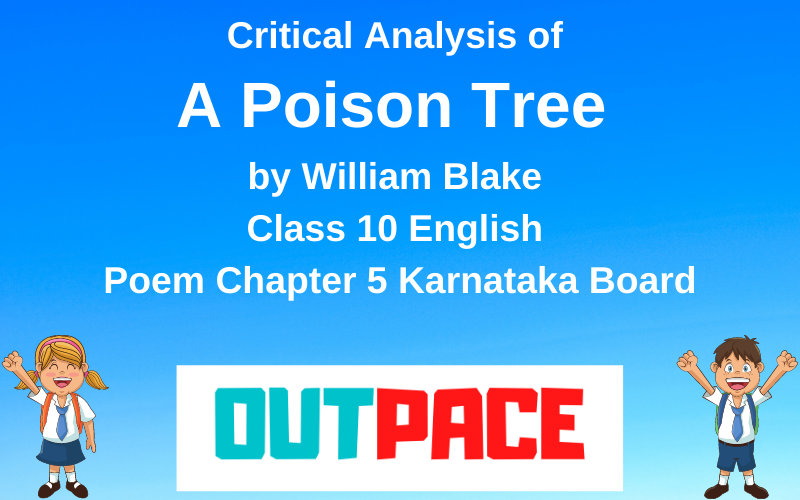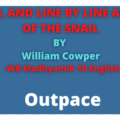You are going to go through Critical Analysis of A Poison Tree by William Blake Class 10 English Poem Chapter 5 Karnataka Board. Understanding a poem meticulously in its entirety is very important for a learner for scoring better in the exam. Efforts have been made to ensure a thorough and proper Textbook Answers Let us find Critical Analysis of A Poison Tree by William Blake Class 10 English Poem Chapter 5 Karnataka Board

About the poet
William Blake was an English craftsman and a Printmaker. Blake is the fundamental figure of the verse and visual crafts of the sentimental age. He took birth on 28 November 1757 at Wide Road, London. His fathers’ name was James, and he was a hosier. William was the third child of their parents among the seven children. He attended school only to learn reading and writing at the age of 10 otherwise his mother used to teach him at home.
William Blake got absolved on 11 December at St. James’ Congregation. The bible was a great and early influence on Blake and also remained a source of inspiration for him. He was never okay with the marriage laws that happened in his time. He raises his voice against the traditional Christian practices of the time.
Blake’s first assortment of sonnets, Poetical Portrayals, got printed around 1783. In 1784 Blake made his inadequate unique duplicate An Island in the Moon. In the 1793’s, Blake was against the cruel relationships of that time. He also resisted the right of women to complete self-fulfillment.
A part of Blake’s rememberable work is “Songs of innocence and experience”, “The Marriage of heaven and hell”, and “the prophetic books”. His verse recommends that outer requests for conjugal loyalty decrease love. A few researchers have noticed that Blake’s point of view on “free love” are both qualified.
Blake’s later works show a reestablished interest in Christianity. William Buttler Yeats has altered a version of Blake’s gathered works in 1893. He additionally drew on him for graceful and philosophical thoughts.
About A Poison Tree by William Blake
Title of A Poison Tree by William Blake
Yes, the title of the poem “A poison tree” is quite appropriate.
The poem Poison Tree is completely based or centered around the feeling of anger. It says that the outcome of a certain connection is to suppress the anger. It treats the more black side of the normal human mind.
The speaker explains that it was easier for him to talk about his anger to his friend than to his enemy. He kept all his anger inside as he couldn’t express it. It started to develop, in the end turning into a figurative tree with poison organic product.
Summary of A Poison Tree by William Blake
The speaker describes being distraught at a companion. The speaker let his companions know about his anger and as a result, his anger got vanished. Whereas, when the speaker was irate with an adversary, the speaker stayed silent. Their indignation at that point expanded.
The speaker built up the anger and continued supporting it to grow with fears and tears, both day and night. The speaker used his fake smiles to hide his anger.
The speaker’s fake smiles and all other attempts to hide the anger increased the anger in place of ending it.
The outrage piled up inside of him till the point it became a tree and bore a beautiful Apple. The speaker’s foe saw this apple making and realized it had a place with the speaker.
The foe snuck into the speaker’s nursery during the dead of night. The speaker was very happy to see the enemy dead the very next morning.
The theme of A Poison Tree by William Blake
Anger and suppressed impression
In the poem “The poison tree” by William Blake, the speaker remembers how he used to be angry at his friend.
The speaker educated their companion about this resentment, which later disappeared. When the speaker was furious with his anger, he kept quiet and the outrage at that point expanded. The speaker presents two unmistakable situations to outline the peril of smothering outrage. But if the speaker would have admitted his anger to his friend, then his anger would have ended. Genuineness and forthrightness, the speaker clarifies, make outrage vanish.
Literary Device used in A Poison Tree by William Blake
Antithesis
end/grow,fears/tears,smiles/wiles,day/night.
Metaphor
the wrath (anger) becomes a tree, a fruit, a poison apple.
Allusion
The apple is an allusion.
Biblical Connection between the Apple and Tree
The wildness of the speaker gets transformed into a tree bearing a poison apple. This implication to the book of Beginning, part 3, is an unmistakable one. The Tree of Information on Great and Evil is the sonnet’s tree. The Snake is the speaker, both enticing and tricky. Furthermore, Adam and Eve are the adversaries, both liable for defiance.




2 thoughts on “Critical Analysis of A Poison Tree by William Blake Class 10 English Poem Chapter 5 Karnataka Board”
Comments are closed.